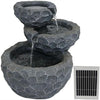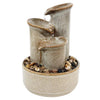The season of flower giving is approaching! Receiving potted flowers for Easter, Mother's Day, or to celebrate spring is a lovely and sweet gesture but knowing how to care for your new plant can be tricky at times. The good news is you don't need to have a green thumb to keep your blossoming gifts alive; you just need a little knowledge and patience. Check out some of the tips below to help keep your Easter and spring flowers blooming and beautiful.
How to Care For Easter Lilies

Tip #1: Don't Overwater
Easter lilies require a small amount of water to flourish. Instead of dousing the plant in water every day, only water the roots of the plant when the top inch of soil feels dry. This will ensure you don't under or overwater the lily. If your lily is in a foil jacket, be sure to remove the liner or cut a hole in the bottom to allow water to drain out. It is important to prevent water from collecting in the bottom of the planter to prevent root rot and promote growth.
Tip # 2: Remove Anthers

Taking the yellow anthers out of this flower allows it to not only grow better and longer, but also keeps the pollen from spilling onto the white petals. This avoids a mess on your table, planter, and the flower itself and prevents stains on your clothes and hands. It is best to remove the anthers just as the petals are opening to avoid staining the flower with pollen. Use tweezers rather than scissors to remove them for a more natural look.
Tip #3: Avoid Direct Sunlight
While sunlight is required for plants to grow, too much sunlight can cause your flowers to wilt and burn. Ensure your Easter lilies are placed somewhere that receives indirect sunlight. These flowers will move toward the sun, so to keep them growing upright, try rotating the pot every few days.
Tip #4: Transplant them Outside
When the weather stays consistently above freezing and doesn't frost and the plant has stopped blooming, you can plant Easter lilies outside in a raised garden bed or directly into the ground. The bulbs should be planted 3 inches deep and covered with soil to grow properly. Be sure to leave 12 inches of space between each bulb. When the plant begins to die, cut the stem to ground level to kickstart new growth for the next blooming season.
How to Care for Tulips
Tip #1: Water Properly
To keep tulips looking bright and beautiful, be sure to water them when the soil surface is dry (usually once or twice a week). If you were given tulips in a foil planter, be sure to remove the foil lining or cut a hole in the bottom to allow water to drain out.
Tip #2: Transplant them Outside
When the flowers have stopped blossoming and the weather is warm enough to prevent frost, tulips can be transplanted from a pot to an outdoor garden.

Start by trimming the dead leaves and flowers from the bulbs. Place the bulbs with the pointy side up 2 inches into a garden bed or the ground. Plant the bulbs 3-5 inches apart. After the bulbs are covered with soil, water them thoroughly.
Tulips can be planted in the spring or fall before frost begins. To ensure your bulbs stay healthy for planting in the fall, let them dry out completely after pruning them. Then, store them in a cool, dry place over the summer. Once you're ready to plant, take them outside and follow the transplanting tips above.
Tip #3: Avoid Direct Sunlight
Tulips grow best when placed in indirect sunlight. Tulips flourish in a cool, bright location, so try placing them in a room with a window (but not in front of the window) that stays cool in your home.
How to Care for Orchids
Tip #1: Water with Ice
The easiest way to water orchids is to use the ice cube method. To do this, according to Better Homes & Gardens, put 3 ice cubes on top of the moss or bark covering the roots once every week. This will slowly water the plant as the ice melts. Monitor the roots of your orchid to determine if you should add or remove an ice cube when watering. Green roots are hydrated while silvery roots need water.
Tip # 2: Avoid Direct Sunlight
Orchids like warmth but can burn easily from too much sun exposure. Keep your orchid in a place with indirect sunlight to ensure it continues to grow.

An easy way to tell if your orchid is getting too much sunlight is by looking at the petals. If the flower petals are red or purple in color, then the plant is burning and needs to be moved away from the light.
Tip #3: Check the Temperature
As stated above, orchids like warm temperatures because they are tropical plants. Try to keep your orchid in a 65 - 75-degree environment with 55 - 75 percent humidity to help it grow. Set the orchid away from fans or vents to prevent exposure to temperature changes throughout the day.
Tip #4: Be Patient
It is normal for plants to go through blooming and hibernation phases. If you notice your orchid beginning to lose its flowers, don't worry. It's probably just entering hibernation. Keep caring for the plant every day and it will bloom again in a few months.
Now you're ready to care for spring flowers as they are given to you this Easter season. You can enjoy the bright spring colors in your home and in your garden when the weather warms. Check out our houseplant guide for more tips on caring for plants in your home.
For more ways to celebrate the Easter season, check out our Easter egg and Easter bunny inflatable decorations!



























































